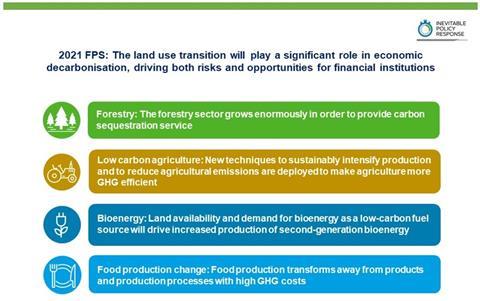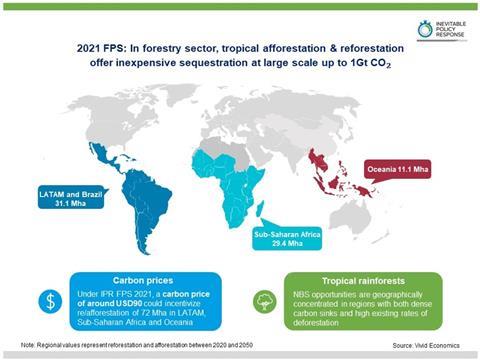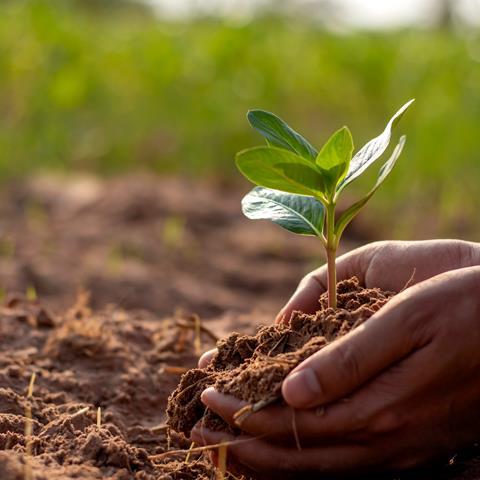Clean Energy is not enough to get the world to 1.5C.
Mass Reforestation and Linking Agriculture with Carbon Pricing are critical to emissions reduction
Land use activity currently contributes approximately 23% of all global greenhouse emissions or more than 10 Gigatons (Gt). The 2021 IPR Forecast Policy Scenario (FPS) has shown that not only can we reduce these emissions without much sacrifice, but we can reverse the damage by allowing forests and nature to return to what they do best, sequestering emissions, aiding biodiversity, and protecting air and water.
At a global level land use across various permutations can be transformed from a net emitter to a net carbon sink.
This shift opens a significant range of opportunities for investors.

Global emphasis is increasing with focus at international forums and COP and on natural capital generally, but compared to fossil fuels and energy, the full emissions reduction potential in Food and Land Use systems is not yet as easily understood by investors, markets and policy makers.
IPR conservatively assesses a potential USD209bn annual revenue from Nature Based Solutions via sequestration by 2050. In mass reafforestation China has the highest deployment potential out to 2050 with Southeast Asia, Sub Saharan Africa and LATAM also figuring prominently.
Three Areas for Focus
Changes in Land-use are needed in 3 areas:
- Animal meat production, particularly beef,
- Industrial agriculture, and
- Management of our forests and other natural areas.
Beef Production: demand to peak in 2030
Globally, methane gas emissions resulting from beef production is a whopper – accounting for 14% of total global emissions – roughly equal to global transportation emissions. Methane is also known to be more harmful than CO2. Even though beef is less than 20% of our diets, its supply chain makes up 80% of the greenhouse emissions in the food sector.
The good news is that for health and environmental reasons, people in developing countries have already started reducing beef consumption and meeting nutritional needs through more plant-based diets, including alternative proteins.
Demand for beef in most developing countries should peak in 2030 according to the 2021 FPS and be 30% less by 2050.
IPR suggests that the acceleration of the three mutually reinforcing mechanisms:
- government policies,
- food innovation and
- consumer behaviour
will reduce meat consumption by a third from its peak and slice nearly 1Gt of emissions off the table.
Much of pastureland that had been used by cows will become available for next generation sustainable biofuel. IPR data shows that using land for biomass versus for cows will reduce emissions and crucially will provide energy for industry and heavy transportation sectors which are more difficult to electrify.
Industrial Agriculture: to experience massive productivity and sustainability gains
The next land factor is industrial agriculture. There is considerable upside in improving farming techniques and productivity. With proper policies and investments in agricultural technology, we can reduce emissions by another 1.3Gt – while also reducing water use and fertilizer use, which would cut nitrogen emissions.
And we can grow 50% more crops per hectare, which has a positive effect on food prices.
Mass Reafforestation: the mother of all land-use solutions
Policy makers and investors also shouldn’t miss the forest for the trees – that’s where the biggest upside will be.
And just in case you’re thinking about that tree-planting field trip you went on in primary school, forests aren’t just a bunch of trees grown together – they’re ecosystems that protect biodiversity.
A tree can be planted in the right or the wrong place, and whether it helps or harms the ecosystem is determined by science, not goodwill.
Tropical forests are super productive for carbon capture. Less demand for beef and stronger deforestation policies mean that fewer forests will be chopped down.
There’s also a multiplier effect - eating less beef along with other measures helps reduces direct bovine emissions by 1Gt and enables avoided deforestation of 4Gt.
IPR scenarios forecast that mass strategic afforestation, and other Nature Based Solutions, (NBS) driven by higher carbon prices and additional supportive policies, will bring in another 4.7Gt in emission abatement.
And these NBS investment opportunities will be especially attractive in Asia, Brazil & Sub-Saharan Africa, an increasingly important consideration for policy makers and investors when considering just transition factors in their decision making.

Turning Land from Net Emitter to Net Carbon Sink
By reducing beef consumption in 2050 by 30% from its peak in 2030, and by converting the land saved from beef pastures for better ‘people food’ and for bioenergy, improving agricultural techniques and more sustainable practices we can turn land from being a net emitter to being a net carbon sink.
Crucially ending deforestation by 2030 while creating more forest is a critical factor where both policy, carbon pricing and investment must combine to maximise the sequestration impact.
However, all of the policy acceleration forecast in IPR FPS 2021 from energy, coal exits, transport, land use etc only puts the world at a 50% chance of holding temperature increase at 1.8C.
Even faster action on deforestation, beef consumption, integration of agriculture in carbon pricing and development of alternative proteins is required to hold temperature increase at the planetary redline of 1.5C.
Investment Implications
What are the implications for investors?
The IPR FPS forecasts a policy acceleration out to the Paris Ratchet in 2025 that includes longer term mitigation measures to reduce emissions from production of crops and livestock in major agricultural producers.
IPR also forecasts growing international climate finance and corporate supply chain pressures on major tropical forest countries to end deforestation.
A closer focus by investors on opportunities in Food and Land use is warranted, as is the potential of mass reforestation schemes on a scale yet to be fully realised.
While energy decarbonisation and its wider sectoral implications rightly dominates much of the climate landscape, Foods and Land Use systems is becoming an increasingly fertile area for those investors looking for additional opportunities in hedging climate risk, long term value creation and emissions reduction.
Tanya Khotin, IPR US Outreach & Land Use Specialist
IPR 2021 detailed Land Use forecasts can be downloaded here.
For more information or a signatory briefing on IPR Land Use and Food Systems forecasts, please contact the PRI.
An edited version of this article first appeared in Environmental Finance on the 9th March.












